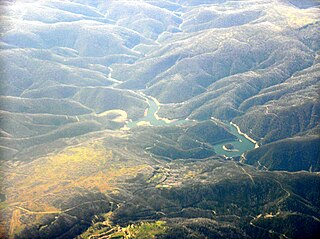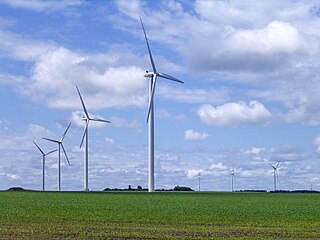
Electricity generation is the process of generating electric power from sources of primary energy. For utilities in the electric power industry, it is the stage prior to its delivery to end users or its storage, using for example, the pumped-storage method.

A substation is a part of an electrical generation, transmission, and distribution system. Substations transform voltage from high to low, or the reverse, or perform any of several other important functions. Between the generating station and consumer, electric power may flow through several substations at different voltage levels. A substation may include transformers to change voltage levels between high transmission voltages and lower distribution voltages, or at the interconnection of two different transmission voltages. They are a common component of the infrastructure. There are 55,000 substations in the United States.

Te Āpiti is a wind farm owned and operated by Meridian Energy. It is located on 11.5 km² of land north of the Manawatū Gorge in the North Island of New Zealand. At 90.75 MW, it was New Zealand's largest capacity wind farm until September 2007, when the third stage of the nearby Tararua Wind Farm was completed.

Iberdrola, S.A. is a Spanish multinational electric utility company based in Bilbao, Spain. It has around 40,000 employees and serves around 30 million customers.

The Tumut Hydroelectric Power Stations is a series of three hydroelectric power stations on the Tumut River in New South Wales, Australia, that are part of the Snowy Mountains Scheme.

Spain is one of the countries with the largest wind power capacity installed, with over 27 GW in 2020. In 2013, it had become the first country in the world to have wind power as its main source of energy.

Renewable energy in Spain, comprising bioenergy, wind, solar, and hydro sources, accounted for 15.0% of the Total Energy Supply (TES) in 2019. Oil was the largest contributor at 42.4% of the TES, followed by gas, which made up 25.4%.
Lotru-Ciunget Dam and Hydro Power Plant is a large hydroelectric complex on the river Lotru situated in Romania and one of the biggest complex facilities in Europe. The complex consists of three hydroelectric power plants. The first and most productive one is Ciunget, the second one is Malaia and the third is Bradisor which, just as Ciunget, is an underground power plant.
El Marquesado Wind Farm has a capacity of 198 megawatts (MW) and is Spain's second largest wind farm, located in Granada. With an annual output of 450 gigawatt hours, the El Marquesado complex encompasses four wind farms, each with a capacity of 49.5 MW. All four sites use Gamesa 2 MW turbines. The facility cost some EUR 250 million to develop.
The Gunning Wind Farm project is a wind farm development in the Cullerin Range, north-east of Gunning, in New South Wales. Wind turbines in the farm are visible from the Hume Highway.

The West Burton power stations are a pair of power stations on the River Trent, near Gainsborough, Lincolnshire, England. West Burton A was a coal-fired power station, which was commissioned in 1966 and operated until 2023. West Burton B on the other hand, is a combined cycle gas turbine power station, commissioned in 2013. West Burton A is owned by EDF Energy, while West Burton B is owned and operated by Totalenergies.

The Hau Nui Wind Farm is a 15-turbine wind farm located approximately 21 kilometres (13 mi) south-east of Martinborough, in the South Wairarapa District of New Zealand. Hau Nui was the first wind farm built in New Zealand.

An electrical grid is an interconnected network for electricity delivery from producers to consumers. Electrical grids consist of power stations, electrical substations to step voltage up or down, electric power transmission to carry power over long distances, and finally electric power distribution to customers. In that last step, voltage is stepped down again to the required service voltage. Power stations are typically built close to energy sources and far from densely populated areas. Electrical grids vary in size and can cover whole countries or continents. From small to large there are microgrids, wide area synchronous grids, and super grids. The combined transmission and distribution network is part of electricity delivery, known as the power grid.
Port Alma Wind Farm is a large wind farm project located on the north shore of Lake Erie in the Municipality of Chatham–Kent, Ontario, Canada.

St. Leon Wind Farm is Manitoba's first wind farm, in St. Leon, Manitoba, Canada. In the first phase completed in 2006, 63 wind turbines were erected over a 93-square-kilometre (36 sq mi) area, capable of delivering 99 megawatts (MW). In 2011 a further 10 turbines were purchased, expanding the capacity of the project to 120 megawatts.
Ocean Power Technologies (OPT) is a U.S. publicly owned renewable energy company, providing electric power and communications solutions, services and related for remote offshore applications. The company's PowerBuoy wave energy conversion technology is theoretically scalable to hundreds of megawatts and the generated energy from wave power can be supplied to the grid via submarine cables. Several projects were undertaken around the world, but the economic viability of the theoretical concept has been problematic.
In 2016, Arizona had 268 megawatts (MW) of wind powered electricity generating capacity, producing 0.5% of in-state generated electricity.
HVDC DolWin1 is a high voltage direct current link built to transmit offshore wind power to the power grid of the German mainland. The project differs from most HVDC systems in that one of the two converter stations is built on a platform in the sea. Voltage-Sourced Converters are used and the total cable length is 165 km. The project was built by ABB and was handed over to its owner, TenneT, in July 2015, the fifth such project to be completed in Germany in 2015.

Humber Gateway Wind Farm is an offshore wind farm 8 kilometres (5 mi) east of Spurn Point off the coast of North East Lincolnshire, in the North Sea, England; the wind farm is located in water depths around 15 metres (49 ft) and covers an area of approximately 25 square kilometres (9.7 sq mi). The wind farm became operational in June 2015.

Renewable energy sources such as solar, wind, tidal, hydro, biomass, and geothermal have become significant sectors of the energy market. The rapid growth of these sources in the 21st century has been prompted by increasing costs of fossil fuels as well as their environmental impact issues that significantly lowered their use.













